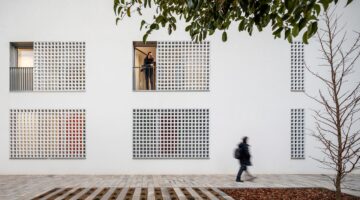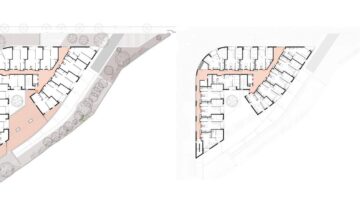




Quatre Camins
Main objectives of the project
The objective of this initiative is to construct public rental accommodations tailored for elderly residents, featuring services specifically designed to enhance mobility and accessibility. Through adaptable rents depending on the tenant’s needs and high-quality architectural design, the building stands as a prominent model of social housing in populated urban areas like Barcelona.
Date
- 2019: Finalista
- 2017: Construction
- 2015: En proceso
Stakeholders
- Architect: Ravetllat Arquitectura
- Promotor: Ajuntament de Barcelon
Location
City:
Country/Region: Barcelona, Spain
Description
Located in a unique area near Collserola's range in Barcelona, Spain, the site plan for this project resides within an urban fabric characterized by low density. This fabric consists of a mix of small-scale isolated family housing alongside larger educational and sanitation facilities. Addressing the challenge of integrating with the existing urban and topographical context was a key consideration during the project's implementation. The overarching objective was to adhere to PassivHaus criteria, emphasizing proper ventilation strategies, thermal insulation, PassivHaus windows, airtightness, and reduced thermal bridging. These measures were designed with a focus on simplicity for the inhabitants' ease of use.
The proposed solution involved an L-shaped building aligned with the streets and oriented to maximize exposure to the best views and sunlight, particularly towards the south or southeast. Access to the 44 dwellings, including two adapted units, is provided via a main core with stairs and elevators, supplemented by a secondary evacuation stair. Leveraging the topography allowed for the creation of two significant communal spaces where elderly residents can engage in outdoor activities. The first space, situated on the first floor, comprises a terrace directly connected to the garden, while the other, on the third floor, links with the laundry facilities and roof area.
This housing complex aims to accommodate senior citizens from low-income social segments on a lifetime rent basis. The rent fee is tailored to the users' personal income and the services provided (e.g., healthcare, food), reflecting their individual situations and autonomy levels. This adaptable fee, coupled with housing made for a targeted vulnerable community, constitutes the primary innovation of the project. Given this context, the architectural design prioritizes economic sensitivity towards its residents and emphasizes easy maintenance and energy efficiency of the apartments. Passive energy control measures take precedence to ensure residents' comfort and minimize administrative complexities.
Furthermore, the project seeks to foster social interaction both within and outside the building, promoting recreational activities that enhance residents' physical and mental well-being while fostering social cohesion within the neighborhood. In summary, the final project optimizes the opportunities presented by the site plan and urban context, demonstrating both an active and passive environmental attitude throughout the building's lifespan, as well as a socially conscious approach.
A significant innovation of the project lies in the implementation of passive energy control measures that not only simplify usage and maintenance but also minimize the ecological footprint, rendering the building environmentally friendly. Additionally, successfully integrating senior citizens into an established residential area represents a significant achievement. Future endeavors include incorporating passive energy control measures into standard administrative practices and extending social initiatives to other neighborhoods, thereby enhancing the quality of life for elderly residents and promoting societal diversity.
The project has won several awards, such as the Ibero-American Passivhaus Competition 2011 or the European Responsible Housing Awards 2019.

